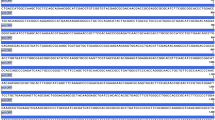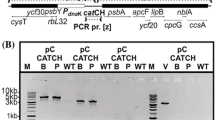Abstract
Synthetic biology and genetic engineering in algae offer an unprecedented opportunity to develop species with traits that can help solve the problems associated with food and energy supply in the 21st century. In the green alga Chlamydomonas reinhardtii, foreign genes can be expressed from the chloroplast genome for molecular farming and metabolic engineering to obtain commodities and high-value molecules. To introduce these genes, selectable markers, which rely mostly on the use of antibiotics, are needed. This has risen social concern associated with the potential risk of horizontal gene transfer across life kingdoms, which has led to a quest for antibiotic-free selectable markers. Phosphorus (P) is a scarce nutrient element that most organisms can only assimilate in its most oxidized form as phosphate (Pi); however, some organisms are able to oxidize phosphite (Phi) to Pi prior to incorporation into the central metabolism of P. As an alternative to the use of the two positive selectable makers already available for chloroplast transformation in C. reinhardtii, the aadA and the aphA-6 genes, that require the use of antibiotics, we investigated if a phosphite-based selection method could be used for the direct recovery of chloroplast transformed lines in this alga. Here we show that following bombardment with a vector carrying the ptxD gene from Pseudomonas stutzeri WM88, only cells that integrate and express the gene proliferate and form colonies using Phi as the sole P source. Our results demonstrate that a selectable marker based on the assimilation of Phi can be used for chloroplasts transformation in a biotechnologically relevant organism. The portable selectable marker we have developed is, in more than 18 years, the latest addition to the markers available for selection of chloroplast transformed cells in C. reinhardtii. The ptxD gene will contribute to the repertoire of tools available for synthetic biology and genetic engineering in the chloroplast of C. reinhardtii.


Similar content being viewed by others
References
Harris, E. H. (2001). Chlamydomoans as a model organism. Annual Review of Plant Physiology and Plant Molecular Biology. https://doi.org/10.1146/annurev.arplant.52.1.363.
Rasala, B. A., & Mayfield, S. P. (2015). Photosynthetic biomanufacturing in green algae; production of recombinant proteins for industrial, nutritional, and medical uses. Photosynthesis Research. https://doi.org/10.1007/s11120-014-9994-7.
Scranton, M. A., Ostrand, J. T., Fields, F. J., & Mayfield, S. P. (2015). Chlamydomonas as a model for biofuels and bio-products production. Plant Journal, 82(3), 523–531. https://doi.org/10.1111/tpj.12780.
Crozet, P., Navarro, F., Willmund, F., Mehrshahi, P., Bakowski, K., Lauersen, K., et al. (2018). Birth of a photosynthetic chassis: A MoClo toolkit enabling synthetic biology in the microalga Chlamydomonas reinhardtii. ACS Synthetic Biology. https://doi.org/10.1021/acssynbio.8b00251.
Almaraz-Delgado, A. L., Flores-Uribe, J., Pérez-España, V. H., Salgado-Manjarrez, E., & Badillo-Corona, J. A. (2014). Production of therapeutic proteins in the chloroplast of Chlamydomonas reinhardtii. AMB Express.. https://doi.org/10.1186/s13568-014-0057-4.
Dyo, Y. M., & Purton, S. (2018). The algal chloroplast as a synthetic biology platform for production of therapeutic proteins. Microbiology (United Kingdom)., 5, 4. https://doi.org/10.1099/mic.0.000599.
Scaife, M. A., Nguyen, G. T. D. T., Rico, J., Lambert, D., Helliwell, K. E., & Smith, A. G. (2015). Establishing Chlamydomonas reinhardtii as an industrial biotechnology host. Plant Journal.. https://doi.org/10.1111/tpj.12781.
Maul, J. E., Lilly, J. W., Cui, L., dePamphilis, C. W., Miller, W., Harris, E. H., et al. (2002). The Chlamydomonas reinhardtii plastid chromosome: islands of genes in a sea of repeats. The Plant Cell. https://doi.org/10.1105/tpc.006155.present.
Gallaher, S. D., Fitz-Gibbon, S. T., Strenkert, D., Purvine, S. O., Pellegrini, M., & Merchant, S. S. (2018). High-throughput sequencing of the chloroplast and mitochondrion of Chlamydomonas reinhardtii to generate improved de novo assemblies, analyze expression patterns and transcript speciation, and evaluate diversity among laboratory strains and wild isolates. Plant Journal.. https://doi.org/10.1111/tpj.13788.
Boynton, J. E., Gillham, N. W., Harris, E. H., Hosler, J. P., Johnson, A. M., Jones, A. R., et al. (1988). Chloroplast transformation in Chlamydomonas with high velocity microprojectiles. Science. https://doi.org/10.1126/science.2897716.
Bertalan, I., Munder, M. C., Weiß, C., Kopf, J., Fischer, D., & Johanningmeier, U. (2015). A rapid, modular and marker-free chloroplast expression system for the green alga Chlamydomonas reinhardtii. Journal of Biotechnology, 195, 60–66. https://doi.org/10.1016/j.jbiotec.2014.12.017.
Bingham, S. E., Xu, R., & Webber, A. N. (1991). Transformation of chloroplasts with the psaB gene encoding a polypeptide of the photosystem I reaction center. FEBS Letters, 5, 4. https://doi.org/10.1016/0014-5793(91)80851-s.
Goldschmidt-clermont, M. (1991). Transgenic expression of aminoglycoside adenine transferase in the chloroplast: A selectable marker for site-directed transformation of chlamydomonas. Nucleic Acids Research. https://doi.org/10.1093/nar/19.15.4083.
Robertson, D., Boynton, J. E., & Gillham, N. W. (1990). Cotranscription of the wild-type chloroplast atpE gene encoding the CF1/CF0 epsilon subunit with the 3′ half of the rps7 gene in Chlamydomonas reinhardtii and characterization of frameshift mutations in atpE. MGG Molecular & General Genetics, 221(2), 155–163. https://doi.org/10.1007/BF00261715.
Chen, H. C., & Melis, A. (2013). Marker-free genetic engineering of the chloroplast in the green microalga Chlamydomonas reinhardtii. Plant Biotechnology Journal, 11(7), 818–828. https://doi.org/10.1111/pbi.12073.
Young, R. E. B., & Purton, S. (2014). Cytosine deaminase as a negative selectable marker for the microalgal chloroplast: A strategy for the isolation of nuclear mutations that affect chloroplast gene expression. Plant Journal, 80(5), 915–925. https://doi.org/10.1111/tpj.12675.
Young, R. E. B., & Purton, S. (2016). Codon reassignment to facilitate genetic engineering and biocontainment in the chloroplast of Chlamydomonas reinhardtii. Plant Biotechnology Journal, 14(5), 1251–1260. https://doi.org/10.1111/pbi.12490.
Economou, C., Wannathong, T., Szaub, J., & Purton, S. (2014). A simple, low-cost method for chloroplast transformation of the green alga Chlamydomonas reinhardtii. Methods in Molecular Biology. https://doi.org/10.1007/978-1-62703-995-6_27.
Shamriz, S., & Ofoghi, H. (2019). Expression of recombinant PfCelTOS antigen in the chloroplast of Chlamydomonas reinhardtii and its potential use in detection of malaria. Molecular Biotechnology, 61(2), 102–110. https://doi.org/10.1007/s12033-018-0140-1.
Shamriz, S., & Ofoghi, H. (2018). Engineering the chloroplast of Chlamydomonas reinhardtii to express the recombinant PfCelTOS-Il2 antigen-adjuvant fusion protein. Journal of Biotechnology, 266, 111–117. https://doi.org/10.1016/j.jbiotec.2017.12.015.
Day, A., & Goldschmidt-Clermont, M. (2011). The chloroplast transformation toolbox: Selectable markers and marker removal. Plant Biotechnology Journal. https://doi.org/10.1111/j.1467-7652.2011.00604.x.
Tabatabaei, I., Dal Bosco, C., Bednarska, M., Ruf, S., Meurer, J., & Bock, R. (2018). A highly efficient sulfadiazine selection system for the generation of transgenic plants and algae. Plant Biotechnology Journal. https://doi.org/10.1111/pbi.13004.
Tabatabaei, I., Ruf, S., & Bock, R. (2017). A bifunctional aminoglycoside acetyltransferase/phosphotransferase conferring tobramycin resistance provides an efficient selectable marker for plastid transformation. Plant Molecular Biology. https://doi.org/10.1007/s11103-016-0560-x.
Bateman, J. M., & Purton, S. (2000). Tools for chloroplast transformation in Chlamydomonas: Expression vectors and a new dominant selectable marker. Molecular and General Genetics. https://doi.org/10.1007/s004380051184.
Sandoval-Vargas, J. M., Macedo-Osorio, K. S., Durán-Figueroa, N. V., Garibay-Orijel, C., & Badillo-Corona, J. A. (2018). Chloroplast engineering of Chlamydomonas reinhardtii to use phosphite as phosphorus source. Algal Research. https://doi.org/10.1016/j.algal.2018.06.003.
Costas, A. M. G., White, A. K., & Metcalf, W. W. (2001). Purification and characterization of a novel phosphorus-oxidizing enzyme from Pseudomonas stutzeri WM88. Journal of Biological Chemistry. https://doi.org/10.1074/jbc.m011764200.
Newman, S. M., Boynton, J. E., Gillham, N. W., Randolph-Anderson, B. L., Johnson, A. M., & Harris, E. H. (1990). Transformation of chloroplast ribosomal RNA genes in Chlamydomonas: Molecular and genetic characterization of integration events. Genetics. https://doi.org/10.1109/camsap.2011.6136016.
Gorman, D. S., & Levine, R. P. (1965). Cytochrome f and plastocyanin: Their sequence in the photosynthetic electron transport chain of Chlamydomonas reinhardtii. Proceedings of the National Academy of Sciences, 54(6), 1665–1669. https://doi.org/10.1073/pnas.54.6.1665.
Guzmán-Zapata, D., Macedo-Osorio, K. S., Almaraz-Delgado, A. L., Durán-Figueroa, N., & Badillo-Corona, J. A. (2016). Production of recombinant proteins in the chloroplast of the green alga Chlamydomonas reinhardtii. Methods in Molecular Biology. https://doi.org/10.1007/978-1-4939-3289-4_5.
Cao, M., Fu, Y., Guo, Y., & Pan, J. (2009). Chlamydomonas (Chlorophyceae) colony PCR. Protoplasma, 235(1–4), 107–110. https://doi.org/10.1007/s00709-009-0036-9.
Towbin, H., Staehelint, T., & Gordon, J. (1979). Electrophoretic transfer of proteins from polyacrylamide gels to nitrocellulose sheets: Procedure and some applications, 76(9), 4350–4354.
Reed, K. C., & Mann, D. A. (1985). Rapid transfer of DNA from agarose gels to nylon membranes. Nucleic Acids Research, 13(20), 7207–7221. https://doi.org/10.1093/nar/13.20.7207.
Sambrook, J., & Russell, D. (2001). Molecular cloning: A laboratory manual (3rd ed.). Cold Spring Harbor: Cold Spring Harbor Laboratory Press.
Loera-Quezada, M. M., Leyva-González, M. A., López-Arredondo, D., & Herrera-Estrella, L. (2015). Phosphite cannot be used as a phosphorus source but is non-toxic for microalgae. Plant Science. https://doi.org/10.1016/j.plantsci.2014.11.015.
Macedo-Osorio, K. S., Pérez-España, V. H., Garibay-Orijel, C., Guzmán-Zapata, D., Durán-Figueroa, N. V., & Badillo-Corona, J. A. (2018). Intercistronic expression elements (IEE) from the chloroplast of Chlamydomonas reinhardtii can be used for the expression of foreign genes in synthetic operons. Plant Molecular Biology. https://doi.org/10.1007/s11103-018-0776-z.
Kanda, K., Ishida, T., Hirota, R., Ono, S., Motomura, K., Ikeda, T., et al. (2014). Application of a phosphite dehydrogenase gene as a novel dominant selection marker for yeasts. Journal of Biotechnology. https://doi.org/10.1016/j.jbiotec.2014.04.012.
López-Arredondo, D. L., & Herrera-Estrella, L. (2012). Engineering phosphorus metabolism in plants to produce a dual fertilization and weed control system. Nature Biotechnology. https://doi.org/10.1038/nbt.2346.
Nahampun, H. N., López-Arredondo, D., Xu, X., Herrera-Estrella, L., & Wang, K. (2016). Assessment of ptxD gene as an alternative selectable marker for Agrobacterium-mediated maize transformation. Plant Cell Reports. https://doi.org/10.1007/s00299-016-1942-x.
Pandeya, D., López-Arredondo, D. L., Janga, M. R., Campbell, L. M., Estrella-Hernández, P., Bagavathiannan, M. V., et al. (2018). Selective fertilization with phosphite allows unhindered growth of cotton plants expressing the ptxD gene while suppressing weeds. Proceedings of the National Academy of Sciences, 5, 4. https://doi.org/10.1073/pnas.1804862115.
Che, P., Anand, A., Wu, E., Sander, J. D., Simon, M. K., Zhu, W., et al. (2018). Developing a flexible, high-efficiency Agrobacterium-mediated sorghum transformation system with broad application. Plant Biotechnology Journal, 5, 4. https://doi.org/10.1111/pbi.12879.
Loera-Quezada, M. M., Leyva-González, M. A., Velázquez-Juárez, G., Sanchez-Calderón, L., Do Nascimento, M., López-Arredondo, D., et al. (2016). A novel genetic engineering platform for the effective management of biological contaminants for the production of microalgae. Plant Biotechnology Journal. https://doi.org/10.1111/pbi.12564.
Motomura, K., Sano, K., Watanabe, S., Kanbara, A., Gamal Nasser, A. H., Ikeda, T., et al. (2018). Synthetic phosphorus metabolic pathway for biosafety and contamination management of cyanobacterial cultivation. ACS Synthetic Biology., 5, 4. https://doi.org/10.1021/acssynbio.8b00199.
Author information
Authors and Affiliations
Corresponding author
Additional information
Publisher's Note
Springer Nature remains neutral with regard to jurisdictional claims in published maps and institutional affiliations.
Rights and permissions
About this article
Cite this article
Sandoval-Vargas, J.M., Jiménez-Clemente, L.A., Macedo-Osorio, K.S. et al. Use of the ptxD gene as a portable selectable marker for chloroplast transformation in Chlamydomonas reinhardtii. Mol Biotechnol 61, 461–468 (2019). https://doi.org/10.1007/s12033-019-00177-3
Published:
Issue Date:
DOI: https://doi.org/10.1007/s12033-019-00177-3




